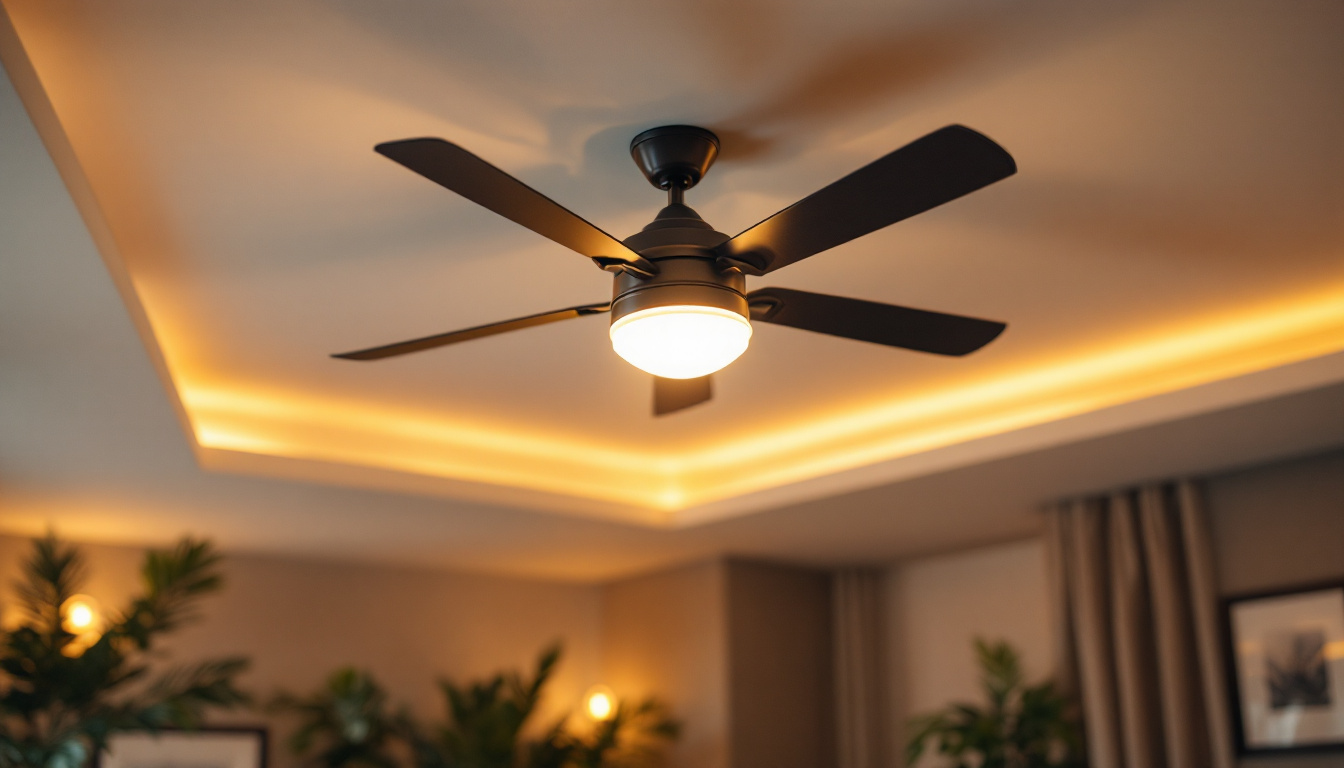

As a lighting contractor, staying informed about various lighting solutions and their integration is crucial. Ceiling fans are often overlooked as key fixtures that not only enhance indoor comfort but also contribute to the overall aesthetics of a space. In this article, we will delve into the essentials of ceiling fans, including their design, function, and how they can be effectively integrated within lighting projects.
Ceiling fans have become a mainstay in both residential and commercial spaces. They are designed to circulate air and can significantly improve comfort levels while reducing reliance on air conditioning. Understanding the basic components of a ceiling fan—including the motor, blades, and housing—is vital for any lighting contractor involved in specifying, installing, or maintaining these fixtures.
The primary purpose of a ceiling fan is to create airflow within a room. This airflow helps regulate temperature, making spaces feel cooler in warm weather and, inversely, pushing warm air down during colder months. The direction of the fan blades can often be reversed, allowing for seasonal adjustments that can create a significant impact on energy efficiency. In fact, many modern ceiling fans come with remote controls or wall switches that make it easy to change the direction of the blades, providing convenience and enhancing user experience.
When selecting a ceiling fan for a project, consider the size of the room and the height of the ceiling. Fans typically come in different blade sizes, and the appropriate size ensures optimal air movement. For example, a fan with 42-inch blades suits smaller rooms effectively, while larger rooms may require fans with 52-inch blades or more to provide adequate airflow. Additionally, the fan’s design should complement the room’s decor, as aesthetics play a crucial role in the overall ambiance of the space. Many manufacturers offer a range of styles and finishes, from polished metals to rustic woods, allowing for a tailored fit in any environment.
Ceiling fans come in various types, each with distinct features and uses. Traditional ceiling fans feature a classic design with decorative elements like light kits. These fans are versatile and fit well in various settings, from modern to rustic interiors. On the other hand, contemporary fans have sleek lines and minimalistic designs, commonly used in modern residential or commercial spaces. Some fans even incorporate LED lighting, which not only enhances energy efficiency but also provides a stylish touch to the overall design.
Additionally, there are outdoor ceiling fans designed to withstand the elements. These fans usually use materials that resist moisture and corrosion, making them a perfect choice for patios and outdoor living spaces. When advising clients on their selection, it’s important to discuss the specific environment where the fan will be installed. Outdoor fans often feature larger blades and more robust motors to handle the increased airflow needs in open spaces, and they may also come equipped with weather-resistant finishes to ensure longevity.
Another type worth mentioning is the smart ceiling fan. These fans can integrate with home automation systems, allowing users to control the fan speed and lighting via smartphone apps or voice commands. As technology evolves, lighting contractors should familiarize themselves with these innovations to meet client demands effectively. Smart fans can also provide energy usage statistics, helping homeowners monitor their consumption and make informed decisions about their energy use. This integration not only enhances convenience but also contributes to a more sustainable lifestyle.
Installation is a critical aspect that can impact both performance and safety. It’s essential to ensure that ceiling fans are installed according to local codes and manufacturer guidelines. The fan must be securely mounted, as improper installation can lead to accidents or decreased performance. Furthermore, it’s advisable to use a fan-rated box, which is specifically designed to support the weight and motion of ceiling fans, ensuring a safe and stable installation.
When preparing for installation, consider the electrical requirements. Many ceiling fans require dedicated circuits, especially those equipped with lights or smart features. Furthermore, ensure the ceiling structure can support the fan’s weight, particularly in cases of larger decorative models. It’s also wise to check the wiring in the ceiling to ensure it meets the necessary standards for fan operation, as outdated or damaged wiring can pose safety risks.
It’s also advisable to educate clients on positioning their fans for optimal efficiency. Ideally, fans should be placed at least 7 feet above the floor to ensure safe operation and effectiveness in airflow distribution. In rooms with high ceilings, the use of downrods may be necessary to achieve the appropriate height. Additionally, positioning fans near the center of the room maximizes airflow and enhances comfort, making it a key consideration during the planning phase of any installation project.
The integration of lighting with ceiling fans is a key consideration for lighting contractors. Many modern ceiling fans come equipped with integrated light kits, providing a dual function in one fixture. This feature not only optimizes space but also enhances the overall lighting scheme of a room. By combining these two elements, homeowners can achieve a streamlined look that reduces clutter and maximizes functionality, making it easier to illuminate a space without the need for multiple separate fixtures.
When selecting a fan with an integrated light kit, it’s important to consider the type of bulb used, as this affects the quality of light provided. LED bulbs are often recommended due to their energy efficiency and longevity. However, it’s vital to ensure that the fan’s design accommodates the heat generated by various light sources, as excessive heat can affect the motor’s lifespan. Additionally, the color temperature of the bulbs can dramatically alter the ambiance of a room; warm white bulbs create a cozy atmosphere, while cool white bulbs can enhance focus and productivity in workspaces.
Another aspect of integration involves coordinating the fan’s aesthetic with the overall room design. For instance, vintage-style fans can complement antique décor, while sleek, modern fans fit well in contemporary settings. Consider discussing various design options with clients to ensure the selected fan aligns with their vision for the space. Furthermore, the choice of materials—such as wood, metal, or glass—can also play a significant role in how well the fan integrates with existing furnishings, allowing for a cohesive design that speaks to the homeowner’s personal style.
In today’s eco-conscious market, energy efficiency is paramount. Ceiling fans can significantly reduce energy costs, particularly in regions with warm climates. By promoting the use of ceiling fans, contractors can help clients achieve sustainable energy solutions, which is both a selling point and a responsible practice. The ability to circulate air effectively can lead to reduced reliance on air conditioning, which not only lowers energy bills but also lessens the environmental impact associated with high energy consumption.
One effective way to enhance energy efficiency is to educate clients on the importance of fan placement and maintenance. Regular cleaning of fan blades ensures optimal performance, as dust buildup can hinder airflow. Additionally, encouraging clients to utilize fans in tandem with their HVAC systems can create a more efficient climate control strategy. For instance, during the summer months, fans can be set to rotate counterclockwise to create a cooling breeze, while in the winter, reversing the direction can help distribute warm air that rises to the ceiling. This dual functionality not only improves comfort but also promotes energy savings throughout the year.
Moreover, the installation of energy-efficient ceiling fans with a high airflow efficiency rating ensures that clients are not only comfortable but are also contributing to energy conservation efforts. With governments and utilities offering incentives for energy-efficient installations, there is an opportunity for contractors to leverage these benefits during discussions with clients. Additionally, as technology advances, smart ceiling fans equipped with Wi-Fi connectivity and programmable settings are becoming increasingly popular, allowing homeowners to control their fans remotely and optimize their energy usage even further. This integration of technology into traditional fixtures represents a significant step forward in creating smarter, more sustainable homes.
Despite their popularity, ceiling fans can encounter various issues that lighting contractors should be prepared to address. Understanding common problems can help you provide effective solutions. One common issue is wobbling, often caused by imbalanced blades. Before installation, it’s advisable to check that all blades are properly aligned and secure.
Noisy fans are another common complaint. Fans can produce noise due to loose parts, poor installation, or motor issues. Installing a fan that features a whisper-quiet motor can be an added selling point to clients who prioritize noise control in their living spaces. If noise persists, lovers of peace may need to engage in a deeper troubleshooting process.
Lastly, clients may encounter concerns regarding remote operation or smart features not functioning correctly. Ensuring proper pairing of remote controls with fans or troubleshooting connections to home automation systems can resolve these issues efficiently. It’s always good practice to prepare clients to understand basic troubleshooting steps.
In conclusion, ceiling fans are versatile fixtures that play a vital role in enhancing comfort and energy efficiency. For lighting contractors, understanding the fundamentals of ceiling fans—including types, integration with lighting, installation considerations, and common issues—will bolster your expertise and ensure you can meet client needs effectively.
As the market continues to evolve, staying updated on trends like smart fans and sustainable options will position you as a knowledgeable resource in your field. By offering insightful recommendations and a professional approach, you can elevate your services and provide clients with comfort, aesthetics, and energy-efficient solutions.
Ready to enhance your lighting projects with high-quality ceiling fans that promise comfort, style, and energy efficiency? Look no further than LumenWholesale. Our extensive selection of spec-grade ceiling fans is designed to meet the highest industry standards, ensuring your clients enjoy reliable and high-performance lighting solutions. With unbeatable wholesale prices and the convenience of free shipping on bulk orders, you can trust LumenWholesale to provide the best value without hidden fees or compromises. Elevate your service offerings and delight your clients with the perfect blend of quality, affordability, and convenience. Wholesale Lighting at the Best Value is just a click away.

Discover why lighting contractors should prioritize replacing fluorescent lights with LEDs.

Discover the transformative impact of 2X2 LED drop ceiling lights on modern lighting projects.

Discover the innovative strategies lighting contractors use to maximize efficiency with high bay LED lights boasting 30,000 lumens.

Discover how choosing the right lamp bulbs can illuminate new business opportunities for lighting contractors.
Get notified when NEW deals are released.
Optimize your budget with wholesale discounts.
Only top-quality, specification-grade lighting products.
No additional costs at checkout - what you see is what you pay.
We understand the unique needs of contractors.